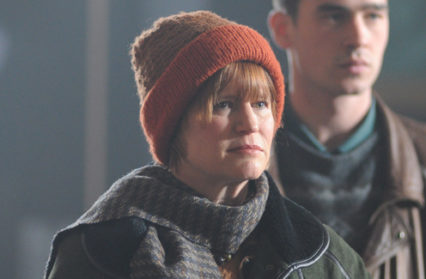The depiction and representation of Welsh women is one of contradictions. Welsh women are portrayed as overtly sexual, and permissive, while simultaneously being maternal and, in turn, pious. Beddoe, in her five identified types, highlights a type which she refers to as ‘The Pious Welsh Woman’, women who have committed spiritual acts of self-sacrifice for religious reasons. In her discussion, Beddoe refers to the painting, Salem, by Sidney Curnow Vosper, a painting which depicts a scene in a Baptist Chapel in Pentre Gwynfryn, North Wales. The painting is not only seen as a depiction of Welsh piety but emphasises the traditional Welsh national costume and the concept of the Welsh Mam.
This concept of piety and religious devotion can still be seen in media representations of women today. While these representations are not always necessarily explicitly religious, there is undoubtedly a pious undercurrent. Notably, this depiction frequently overlaps with the concept of the Welsh Mam, linking the matriarch with moral self-sacrifice.
Perhaps the most overtly religious depiction in recent years is the Welsh women in Pride. The film, detailing the involvement of a group of gay and lesbian activists in supporting the miner’s strikes, has, deservedly, received much praise. Yet the depiction of Wales, and the Welsh women, in particular, is questionable.
Despite the film taking place in 1984, the film’s portrayal of Onllwyn renders the area as entirely isolated and separate from popular culture. Indeed, the very mood and tone of the village would be better suited to a narrative taking place decades earlier. While the majority of the village’s inhabitants warmly welcome the activists, Maureen Barry, an archetypical matriarch is firmly against forming ties with the group. Thus, the film’s narrative, in depicting a clear juxtaposition between the traditional Welsh village and the metropolitan, ‘woke’ London, clearly conflates religious piety with a lack of progressive thought.
Barry’s character adheres to traditional values, and in doing so, deservedly receives disdain. Yet, to so easily and simplistically conflate these abhorrent views with a lack of progression, and in turn, a specific geographical place means that Barry’s views are directly linked to her nationality. Similarly, the other women in the village, while certainly not sharing Barry’s views (and indeed profess their clear disgust for her perspective) are too lacking in progression. Arriving in London the women, spending the night out with the activists, are suddenly imbued with a new vigour and excitement. Highlighting once again, that their geographical location is holding them back in some way, and that a simple removal from this space is enough to allow them freedom.
The very concept of piety is one that regularly receives open disdain, the term increasingly interchangeable with narrow mindedness and questionable views. Thus, any Welsh woman who is represented as obviously pious is demanding of immediate interrogation. This depiction should be analysed as it is clear that, all too often, this interpretation is wilfully linked to national identity. In doing so, the viewer immediately, arguably subconsciously, links national identity and in turn, pride in national heritage, to a lack of progressive thought and developed views.
Frequently, the pious Welsh women is, in being the familial matriarch, represented as limited in her experiences and in turn, her opinions. This Welsh woman is one who has not experienced other areas, or other cultures, and in turn, becomes a figure of mockery inviting scorn and derision. This conflation is when assessed, quickly rendered as damaging, becoming a rather odd conflation of hyperbolic evangelism with a maternal instinct. What is this then suggesting? That religion in all forms leads to uncertain devoutness? That the maternal nature can, when linked to such devotion and virtue, become an issue? Certainly, this appears to be the implication in the case of Barry. Her application of religious zeal, imbued within her sons through their familial relationship, is one that is, quite rightly, intended to garner odium. Yet, presenting such a depiction without little analysis or discussion creates a portrayal that is overly simplistic.
It should be noted that while Beddoe’s reference to piety is inherently religious when discussing contemporary representations this piety easily translates to a devotion to tradition or, frequently a lack of progressive thought. Thus, a character which demonstrates an especially traditional perspective is often deemed as lacking in advancement, and in turn, is problematic, particularly when this lack is so basically combined with nationality.











